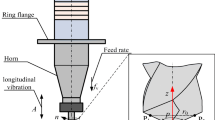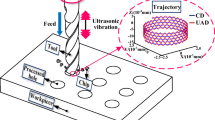Abstract
Drilling titanium alloys are difficult because of the inherent material properties, particularly the low thermal conductivity and high chemical reactivity. This paper presents the design of a frequency tracing system and the experimental investigation in ultrasonic-assisted drilling (UAD) of titanium alloy. In order to realize the degree of influence between developed frequency tracing system and cutting parameters (frequency tracing, operating voltage, drill diameter, feed rate, and spindle speed) in UAD of titanium alloy, a L18 (2 × 37) orthogonal array was employed. Based on the experimental results, the importance of drill diameter, feed rate, and spindle speed in assessing thrust force is highlighted. On the other hand, average thrust force reduction of 3.2% was realized with frequency tracing compared to without the frequency tracing counterpart in UAD of titanium alloy. Moreover, the best combination to get lower thrust force in UAD of titanium alloy is A2B2C3D1E3 (i.e., frequency tracing = YES, operating voltage = 500 V, drill diameter = 3 mm, feed rate = 10 mm/min, and spindle speed = 1,000 rpm) within the selected test range.
Similar content being viewed by others
References
Brinksmeier E (1990) Prediction of tool fracture in drilling. CIRP Ann 39(1):97–100, doi:10.1016/S0007-8506(07)61011-7
Chang SSF, Bone GM (2005) Burr size reduction in drilling by ultrasonic assistance. Rob Comput Integr Manuf 21:442–450, doi:10.1016/j.rcim.2004.11.005
Neugebauer R, Stoll A (2004) Ultrasonic application in drilling. J Mater Process Technol 149:633–639, doi:10.1016/j.jmatprotec.2003.10.062
Zhang LB, Wang LJ, Liu XY, Zhao HW, Wang X, Luo HY (2001) Mechanical model for predicting thrust and torque in vibration drilling fibre-reinforced composite materials. Int J Mach Tools Manuf 41(5):641–657, doi:10.1016/S0890-6955(00)00105-X
Onikura H, Ohnishi O, Feng JH, Kanda T, Morita T, Bopp U (1996) Effects of ultrasonic vibration on machining accuracy in microdrilling. Int J Jpn Soc Prec Eng 30(3):210–216
Jin M, Murakawa M (2001) Development of a practical ultrasonic vibration cutting tool system. J Mater Process Technol 113:342–347, doi:10.1016/S0924-0136(01)00649-5
Takeyama H, Kato S (1991) Burrless drilling by means of ultrasonic vibration. CIRP Ann 40(1):83–86, doi:10.1016/S0007-8506(07)61939-8
Azarhoushang B, Akbari J (2007) Ultrasonic-assisted drilling of Inconel 738-LC. Int J Mach Tools Manuf 47:1027–1033, doi:10.1016/j.ijmachtools.2006.10.007
Kuo KL (2007) Experimental investigation of ultrasonic vibration-assisted tapping. J Mater Process Technol 192-193:306–311, doi:10.1016/j.jmatprotec.2007.04.033
Babitsky VI, Astashev VK, Meadows A (2007) Vibration excitation and energy transfer during ultrasonically assisted drilling. J Sound Vibrat 308:805–814, doi:10.1016/j.jsv.2007.03.064
Thomas PNH, Babitsky VI (2007) Experiments and simulations on ultrasonically assisted drilling. J Sound Vibrat 308:815–830, doi:10.1016/j.jsv.2007.03.081
Sun XQ, Masuzawa T, Fujino M (1996) Micro ultrasonic machining and its applications in MEMS. Sens Actuators A Phys 57:159–164, doi:10.1016/S0924-4247(97)80107-0
Kim JD, Lee ES (1996) A study of ultrasonic vibration cutting of carbon fibre reinforced plastics. Int J Adv Manuf Technol 12(2):78–86, doi:10.1007/BF01178947
Pei ZJ, Ferreira PM (1998) Modelling of ductile-mode material removal in rotary ultrasonic machining. Int J Mach Tools Manuf 38:1399–1418, doi:10.1016/S0890-6955(98)00007-8
Zhixin J, Jianhua Z, Xing A (1997) Study on a new kind of combined machining technology of ultrasonic machining and electrical discharge machining. Int J Mach Tools Manuf 37(2):193–199, doi:10.1016/S0890-6955(96)00048-X
Zhong ZW, Lin G (2006) Ultrasonic assisted turning of an aluminium-based metal matrix composite reinforced with SiC particles. Int J Adv Manuf Technol 27:1077–1081, doi:10.1007/s00170-004-2320-3
Liu K, Li XP, Rahman M (2008) Characteristics of ultrasonic vibration-assisted ductile mode cutting of tungsten carbide. Int J Adv Manuf Technol 35:833–841, doi:10.1007/s00170-006-0761-6
Caldara S, Nuccio S, Spataro C (1998) A virtual instrument for measurement of flicker. IEEE Trans Instrum Meas 47(5):1155–1158, doi:10.1109/19.746574
Angrisani L, Daponte P, D’Apuzzo M (1998) A virtual digital signal-processing instrument for measuring superimposed power line disturbances. Meas 24(1):9–19, doi:10.1016/S0263-2241(98)00033-5
Wang C, Gao R (2000) A virtual instrumentation system for integrated bearing condition monitoring. IEEE Trans Instrum Meas 49(2):325–332, doi:10.1109/19.843072
Topalis FV, Gonos F, Vokas GA (2001) Arbitrary waveform generator for harmonic distortion tests on compact fluorescent lamps. Meas 30(4):257–267, doi:10.1016/S0263-2241(01)00017-3
Bilski P, Winiecki W (2002) A virtual spectrum analyzer based on data acquisition card. IEEE Trans Instrum Meas 51(1):82–87, doi:10.1109/19.989906
Pantelic-Babic J, Jankovic V, Bosnjakovic P (2002) System for electromotive force standards comparison based on virtual instrument. IEEE Trans Instrum Meas 51(6):1295–1299, doi:10.1109/TIM.2002.808017
Locci N, Muscas C, Ghiani E (2002) Evaluation of uncertainty in measurements based on digitized data. Meas 32(4):265–272
Lipovszki G, Aradi P (2006) Simulating complex systems and processes in LabVIEW. J Math Sci 132(5):629–636, doi:10.1007/s10958-006-0007-z
Salehi D, Brandt M (2006) Melt pool temperature control using LabVIEW in Nd:YAG laser blown powder cladding process. Int J Adv Manuf Technol 29:273–278, doi:10.1007/s00170-005-2514-3
Shi DF, Axinte DA, Gindy NN (2006) Online machining process monitoring using wavelet transform and SPC. In: IEEE Instrum Meas Technol Conf, April, Sorrento, Italy, pp 2081–2086
Author information
Authors and Affiliations
Corresponding author
Rights and permissions
About this article
Cite this article
Hsu, I., Tsao, C.C. Study on the effect of frequency tracing in ultrasonic-assisted drilling of titanium alloy. Int J Adv Manuf Technol 43, 127–135 (2009). https://doi.org/10.1007/s00170-008-1696-x
Received:
Accepted:
Published:
Issue Date:
DOI: https://doi.org/10.1007/s00170-008-1696-x




